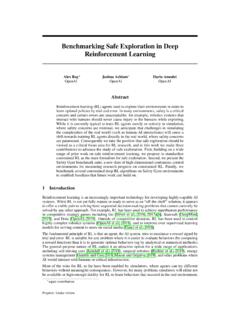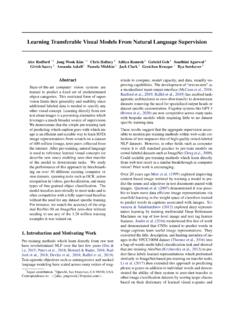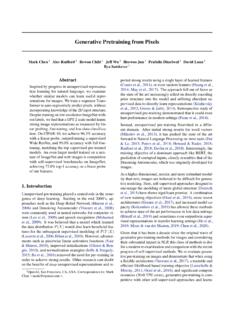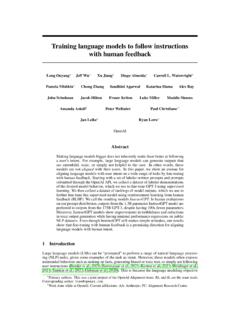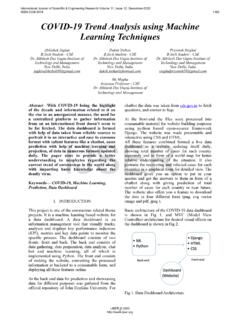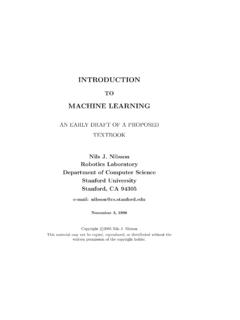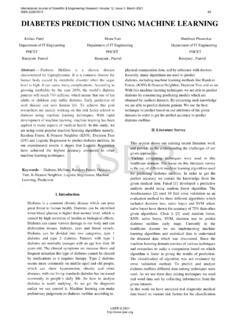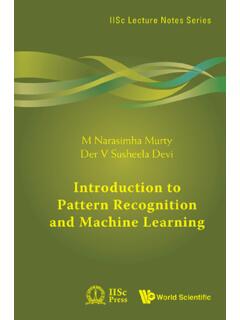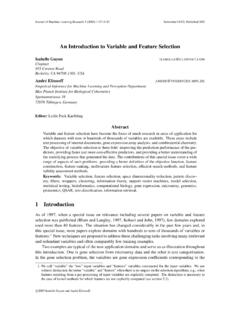Transcription of Improving Language Understanding by Generative Pre-Training
1 Improving Language Understandingby Generative Pre-TrainingAlec Language Understanding comprises a wide range of diverse tasks suchas textual entailment, question answering, semantic similarity assessment, anddocument classification. Although large unlabeled text corpora are abundant,labeled data for learning these specific tasks is scarce, making it challenging fordiscriminatively trained models to perform adequately. We demonstrate that largegains on these tasks can be realized bygenerative pre-trainingof a Language modelon a diverse corpus of unlabeled text, followed bydiscriminative fine-tuningon eachspecific task. In contrast to previous approaches, we make use of task-aware inputtransformations during fine-tuning to achieve effective transfer while requiringminimal changes to the model architecture. We demonstrate the effectiveness ofour approach on a wide range of benchmarks for natural Language general task-agnostic model outperforms discriminatively trained models thatuse architectures specifically crafted for each task, significantly Improving upon thestate of the art in 9 out of the 12 tasks studied.
2 For instance, we achieve absoluteimprovements of on commonsense reasoning (Stories Cloze Test), onquestion answering (RACE), and on textual entailment (MultiNLI).1 IntroductionThe ability to learn effectively from raw text is crucial to alleviating the dependence on supervisedlearning in natural Language processing (NLP). Most deep learning methods require substantialamounts of manually labeled data, which restricts their applicability in many domains that sufferfrom a dearth of annotated resources [61]. In these situations, models that can leverage linguisticinformation from unlabeled data provide a valuable alternative to gathering more annotation, whichcan be time-consuming and expensive. Further, even in cases where considerable supervisionis available, learning good representations in an unsupervised fashion can provide a significantperformance boost.
3 The most compelling evidence for this so far has been the extensive use of pre-trained word embeddings [10,39,42] to improve performance on a range of NLP tasks [8,11,26,45].Leveraging more than word-level information from unlabeled text, however, is challenging for twomain reasons. First, it is unclear what type of optimization objectives are most effective at learningtext representations that are useful for transfer. Recent research has looked at various objectivessuch as Language modeling [44], machine translation [38], and discourse coherence [22], with eachmethod outperforming the others on different , there is no consensus on the mosteffective way to transfer these learned representations to the target task. Existing techniques involvea combination of making task-specific changes to the model architecture [43,44], using intricatelearning schemes [21] and adding auxiliary learning objectives [50].
4 These uncertainties have madeit difficult to develop effective semi-supervised learning approaches for Language Work in this paper, we explore a semi-supervised approach for Language Understanding tasks using acombination of unsupervised Pre-Training and supervised fine-tuning. Our goal is to learn a universalrepresentation that transfers with little adaptation to a wide range of tasks. We assume access toa large corpus of unlabeled text and several datasets with manually annotated training examples(target tasks). Our setup does not require these target tasks to be in the same domain as the unlabeledcorpus. We employ a two-stage training procedure. First, we use a Language modeling objective onthe unlabeled data to learn the initial parameters of a neural network model. Subsequently, we adaptthese parameters to a target task using the corresponding supervised our model architecture, we use theTransformer[62], which has been shown to perform strongly onvarious tasks such as machine translation [62], document generation [34], and syntactic parsing [29].
5 This model choice provides us with a more structured memory for handling long-term dependencies intext, compared to alternatives like recurrent networks, resulting in robust transfer performance acrossdiverse tasks. During transfer, we utilize task-specific input adaptations derived from traversal-styleapproaches [52], which process structured text input as a single contiguous sequence of tokens. Aswe demonstrate in our experiments, these adaptations enable us to fine-tune effectively with minimalchanges to the architecture of the pre-trained evaluate our approach on four types of Language Understanding tasks natural Language inference,question answering, semantic similarity, and text classification. Our general task-agnostic modeloutperforms discriminatively trained models that employ architectures specifically crafted for eachtask, significantly Improving upon the state of the art in 9 out of the 12 tasks studied.
6 For instance,we achieve absolute improvements of on commonsense reasoning (Stories Cloze Test) [40], on question answering (RACE) [30], on textual entailment (MultiNLI) [66] and onthe recently introduced GLUE multi-task benchmark [64]. We also analyzed zero-shot behaviorsof the pre-trained model on four different settings and demonstrate that it acquires useful linguisticknowledge for downstream Related WorkSemi-supervised learning for NLPOur work broadly falls under the category of semi-supervisedlearning for natural Language . This paradigm has attracted significant interest, with applications totasks like sequence labeling [24,33,57] or text classification [41,70]. The earliest approaches usedunlabeled data to compute word-level or phrase-level statistics, which were then used as features in asupervised model [33]. Over the last few years, researchers have demonstrated the benefits of usingword embeddings [11,39,42], which are trained on unlabeled corpora, to improve performance on avariety of tasks [8,11,26,45].
7 These approaches, however, mainly transfer word-level information,whereas we aim to capture higher-level approaches have investigated learning and utilizing more than word-level semantics fromunlabeled data. Phrase-level or sentence-level embeddings, which can be trained using an unlabeledcorpus, have been used to encode text into suitable vector representations for various target tasks [28,32, 1, 36, 22, 12, 56, 31].Unsupervised pre-trainingUnsupervised Pre-Training is a special case of semi-supervised learningwhere the goal is to find a good initialization point instead of modifying the supervised learningobjective. Early works explored the use of the technique in image classification [20,49,63] andregression tasks [3]. Subsequent research [15] demonstrated that Pre-Training acts as a regularizationscheme, enabling better generalization in deep neural networks.
8 In recent work, the method hasbeen used to help train deep neural networks on various tasks like image classification [69], speechrecognition [68], entity disambiguation [17] and machine translation [48].The closest line of work to ours involves Pre-Training a neural network using a Language modelingobjective and then fine-tuning it on a target task with supervision. Dai et al. [13] and Howard andRuder [21] follow this method to improve text classification. However, although the pre-trainingphase helps capture some linguistic information, their usage of LSTM models restricts their predictionability to a short range. In contrast, our choice of transformer networks allows us to capture longer-range linguistic structure, as demonstrated in our experiments. Further, we also demonstrate theeffectiveness of our model on a wider range of tasks including natural Language inference, paraphrasedetection and story completion.
9 Other approaches [43,44,38] use hidden representations from a2pre-trained Language or machine translation model as auxiliary features while training a supervisedmodel on the target task. This involves a substantial amount of new parameters for each separatetarget task, whereas we require minimal changes to our model architecture during training objectivesAdding auxiliary unsupervised training objectives is an alternativeform of semi-supervised learning . Early work by Collobert and Weston [10] used a wide variety ofauxiliary NLP tasks such as POS tagging, chunking, named entity recognition, and Language modelingto improve semantic role labeling. More recently, Rei [50] added an auxiliary Language modelingobjective to their target task objective and demonstrated performance gains on sequence labelingtasks. Our experiments also use an auxiliary objective, but as we show, unsupervised pre-trainingalready learns several linguistic aspects relevant to target FrameworkOur training procedure consists of two stages.
10 The first stage is learning a high-capacity languagemodel on a large corpus of text. This is followed by a fine-tuning stage, where we adapt the model toa discriminative task with labeled Unsupervised pre-trainingGiven an unsupervised corpus of tokensU={u1,..,un}, we use a standard Language modelingobjective to maximize the following likelihood:L1(U) = ilogP(ui|ui k,..,ui 1; )(1)wherekis the size of the context window, and the conditional probabilityPis modeled using a neuralnetwork with parameters . These parameters are trained using stochastic gradient descent [51].In our experiments, we use a multi-layerTransformer decoder[34] for the Language model, which isa variant of the transformer [62]. This model applies a multi-headed self-attention operation over theinput context tokens followed by position-wise feedforward layers to produce an output distributionover target tokens:h0=UWe+Wphl=transformer_block(hl 1) i [1,n]P(u) =softmax(hnWTe)(2)whereU= (u k.)



